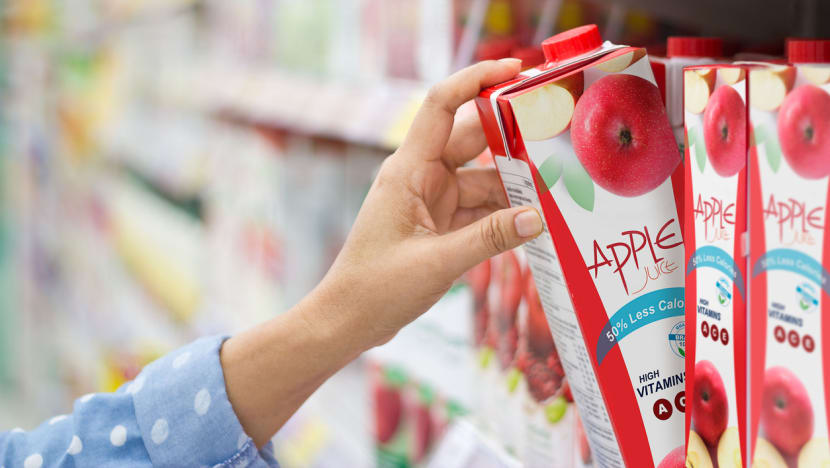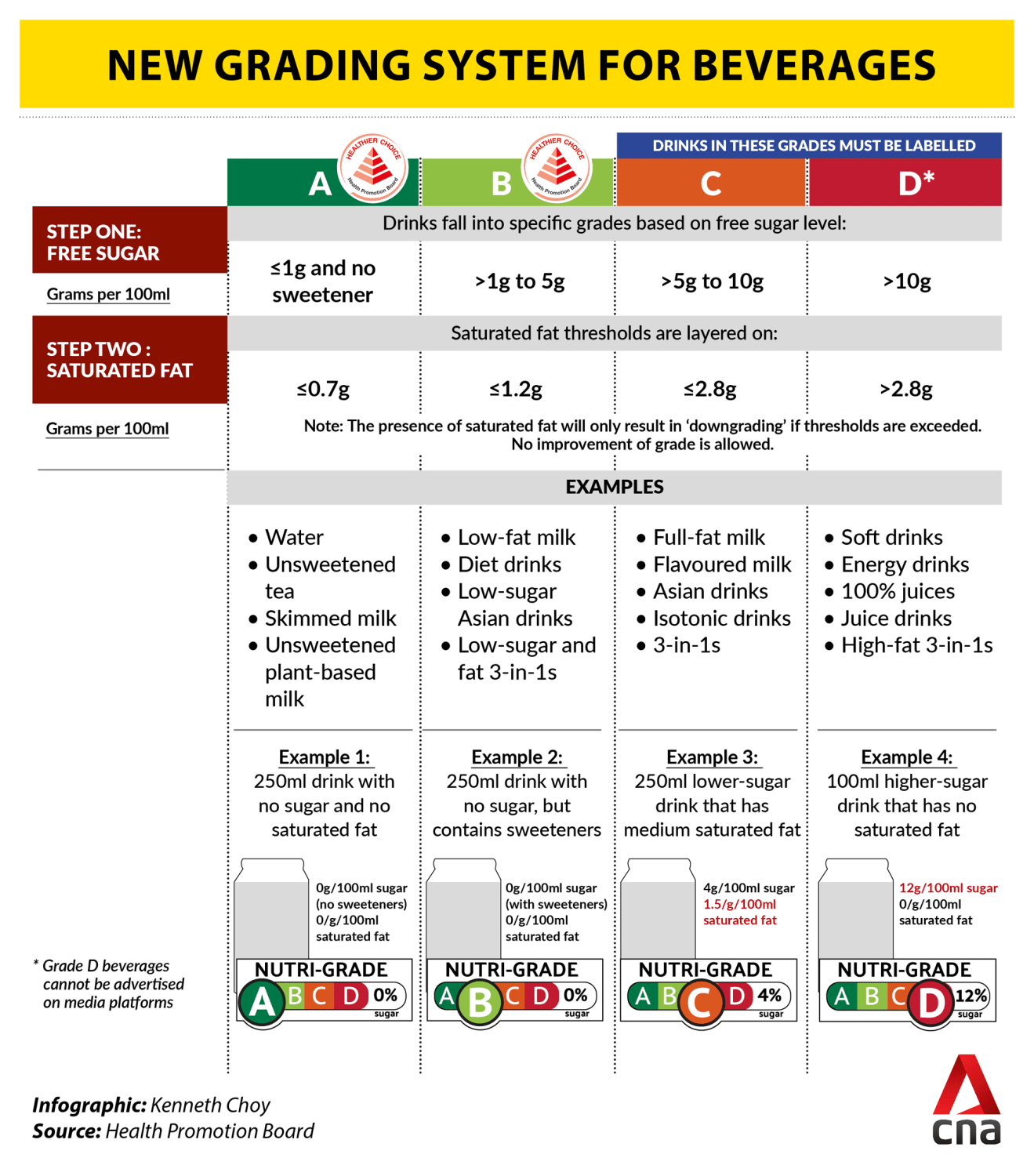CNA Explains: Why do some 'healthier' drinks have a poorer Nutri-Grade than soft drinks?
The new mandatory label for pre-packaged drinks has left some scratching their heads over the poorer grades of fresh milk and pure fruit juice.

A customer picks a packet of apple juice from a supermarket shelf. (File photo: iStock)
SINGAPORE: If you were to grade how healthy fresh milk is from A to D, with D being the poorest possible score, what would you give it?
Chances are, you might have given it at least a B or even an A.
But under a new mandatory labelling scheme for pre-packaged beverages called Nutri-Grade, most fresh milk has been assigned a C grade.
Low-fat milk, on the other hand, generally received a B grade.
Implemented in December last year, the Nutri-Grade scheme assigns colour-coded grades from A to D, with D containing the highest sugar or saturated fat content.
Those labelled D are prohibited from being advertised in the media.

A search on Fairprice Online for "100 per cent juice" revealed that out of the 70 listings of Nutri-Grade beverages available, 61 of them had either a C or D grade.
This places them in the same categories as regular isotonic drinks, which generally have a C grade or soft drinks like Coca-Cola Classic which has a D grade.
In contrast, some flavoured soft drinks such as F&N’s Sarsi and Fanta Orange were stamped with a B grade.
But does this mean that they are healthier than fresh milk and pure fruit juice?
Here's what we know.
What do the different grades mean?
The grading system is based on the sugar and saturated fat content in the drink, both of which are linked to the risk of diabetes.
Take F&N Magnolia Fresh Milk, for example.
According to its nutrition information label, it has a total of 4.0g of fat and 4.3g of sugar per 100ml. However, the label also states that all the sugar comes naturally from the milk.
Under current Nutri-Grade guidelines, lactose (sugar found in milk and milk products) or galactose (usually found in lactose) declared on the nutrition information panel is subtracted from the amount of total sugar for the purpose of grading.
Hence, based on the set of thresholds used for the Nutri-Grade system, this explains why F&N Magnolia Fresh Milk - which has a saturated fat content of more than 2.8g per 100ml but no added sugar - would get a C rating.
On the other hand, F&N’s Sarsi has a sugar content of 4.9g per 100ml, which is just under the Grade C threshold of more than 5g per 100ml. Therefore, it has a B grade.
Does a higher grade mean that a drink is healthier?
Not necessarily, according to dietitians and nutritionists CNA spoke to.
“The Nutri-Grade system works with a very narrow bandwidth of nutrients - only fats and sugar - this skews the grading, making even generally healthy foods and drinks to be ranked a C, which is really not the case from a holistic perspective,” said nutritionist Sheeba Majmudar.
Temasek Polytechnic’s Kalpana Bhaskaran, who heads the Glycemic Index Research Unit at the School of Applied Science, said the idea behind including only saturated fat and sugar on the NutriGrade label is to provide a simple way for consumers to identify foods that are high in these two nutrients.
“There is evidence-based research on the link between poor diet quality, especially the excess intake of sugar and saturated fat, to the epidemic of non-communicable diseases,” she said, adding this includes diabetes, cardiovascular diseases and cancer.
According to the Health Promotion Board (HPB), Singaporeans consume 12 teaspoons or 60g of sugar daily on average. More than half of their daily sugar intake comes from beverages, of which pre-packed beverages contribute 64 per cent.
“(The Nutri-Grade initiative) may be like first-level screening,” said Dr Bhaskaran.
“However, it's important to note that many other nutrients, such as fibre, vitamins, and minerals, also play a crucial role in overall health and should not be ignored," she added.
Meanwhile, Ms Jaclyn Reutens, a dietitian at Aptima Nutrition, said some groups of individuals, such as underweight children and the elderly may also need to drink fresh milk instead of low-fat milk.
“(Fresh milk and pure juice) are certainly not less healthy than soft drinks,” she said.
“Soft drinks are empty calories, meaning that they provide calories with zero nutrients.”
“Fresh milk, albeit higher in saturated fat, is an excellent source of protein and calcium. 100 per cent fruit juice, despite being higher in (natural) sugar, contains vitamins A and C, potassium and a host of phytochemicals,” she added.
Dr Bhaskaran said it would be more practical to compare beverages within the same category.
“For example, if you are planning to consume soft drinks, go for B grade rather than choosing C or D, which contains a higher amount of sugar that adds only ‘empty’ calories and not any nutrients,” she said.
In their response to such concerns raised during a public consultation on the grading scheme in 2020, MOH and HPB emphasised that the scheme is focused on sugar and saturated fat content, and that the scheme will work together with public education efforts to promote healthier diets.
“MOH and HPB recognise the nutritional benefits of full-fat milk and 100 per cent juices, and intend to highlight these as part of our public educational efforts,” they said.
On the healthcare platform Healthhub, it states that plain full cream milk is graded C due to its higher saturated fat content compared to low-fat milk.
“For one- to two-year-olds, plain full cream milk still meets the dietary requirements of adequate fat, protein, vitamins and minerals which are essential for their growth and development,” the website said.
Why don’t all drinks have a Nutri-Grade label?
Currently, the labelling system applies to pre-packaged beverages including those that come in bottles, cans, cartons or packets; powders or concentrates such as 3-in-1 instant coffee beverages and cordials.
Drinks dispensed from automated beverage dispensers such as fountain drinks and automated coffee machines are also required to bear the Nutri-Grade labels.
While all Nutri-Grade beverages are required to provide their nutrition information, only those that are graded C or D must have their Nutri-Grade labels on the front of the package.
For beverages graded A or B, this is optional and they can also use the voluntary Healthier Choice Symbol or Healthier Dining Programme identifier.
From end-2023, freshly prepared beverages that are prepared by hand where they are sold, or those that can be customised by the consumer including freshly brewed coffee and bubble tea will also come under the Nutri-Grade system.
Editor's note: Reference to Sprite has been removed this article after Coca-Cola Singapore clarified that while some varieties of the beverage available in Singapore do have a D rating, this is for some supplies imported from Indonesia. Those imported from Malaysia have a B rating.


















